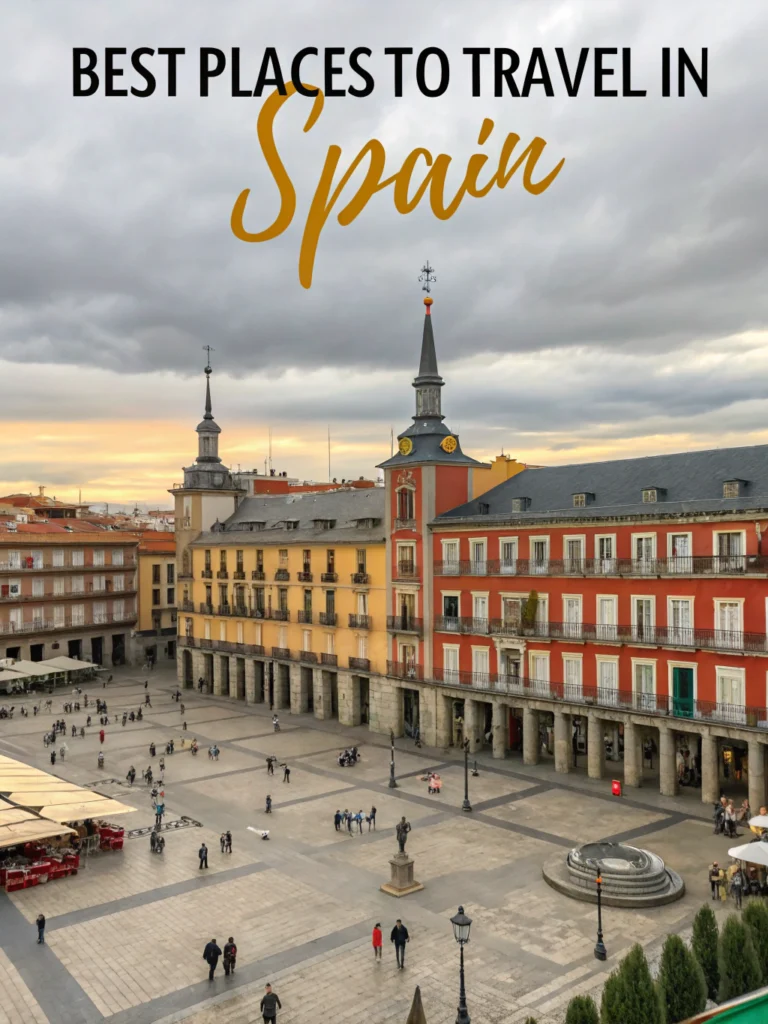Best Time to Travel to Spain: 5 Tips for your perfect trip
Table of Contents
When Is the Best Time to Visit Spain? Your Ultimate Seasonal Guide
Imagine strolling the maze-like alleys of Barcelona’s Gothic Quarter, sunlight filtering through centuries-old stone buildings as you relax with a glass of sangria in a lively square buzzing with local energy. Or imagine standing in awe at the Alhambra’s intricate architecture, the golden hues of sunset casting a magical glow over Granada. Spain is a country that captivates every traveler—but to make the most of your trip, timing is everything.
The ideal time to visit Spain varies based on the experiences you’re seeking during your trip . Do you crave sunny beach days, lively festivals, or peaceful explorations without the crowds? Maybe you’re looking for the cheapest flights or the most pleasant weather. Whatever your preference, this guide will help you plan the perfect Spanish getaway with five essential tips.

1. Understanding Spain’s Climate – When to Go for Ideal Weather
Spain’s climate shifts noticeably across its regions. The northern areas are green and temperate, the southern parts bask under the intense Andalusian sun, while the islands benefit from a year-round spring-like atmosphere. Here’s what you need to know before booking your trip.

Best Months for Comfortable Travel
- Spring (April – June): Mild temperatures (15°C – 25°C), blooming flowers, and fewer tourists make this the sweet spot for sightseeing.
- Fall (September – October): Warm but not scorching, perfect for city breaks and coastal trips before the winter chill sets in.
- Summer (July – August): Intense heat (often 30°C+), best for beach lovers in Costa Brava or the Balearic Islands.
- Winter (November – March): Cool and sometimes rainy, but ideal for skiing in Sierra Nevada or exploring Madrid without the crowds.
Book your flight to Spain.
Book your hotel in Spain.
Regional Weather Differences
| Region | Best Time to Visit | Weather Highlights |
|---|---|---|
| Andalusia | Spring/Fall | Avoid July-August’s extreme heat |
| Barcelona | May – June | Sunny but not humid |
| Madrid | September – October | Pleasant city walks |
| Canary Islands | Year-round | Always mild (18°C – 24°C) |
If you dislike extreme heat, avoid southern Spain in peak summer. On the flip side, if you’re visiting in winter, be sure to bring layers—Madrid’s temperatures can drop quite a bit.
2. Avoiding Crowds – Traveling in Shoulder Seasons
There’s nothing worse than fighting through hordes of tourists at the Sagrada Família or struggling to find a quiet spot on a packed beach. To enjoy Spain with more space and less stress, timing is key.
Best Times for Fewer Tourists
- From late April through early June : the period following Easter and just before the summer vacation rush.
- September – October: Summer crowds have left, but the weather is still warm.
- Winter (excluding Christmas): Cities like Seville and Granada are peaceful.
Popular Events That Draw Big Crowds
- La Tomatina (August): Buñol hosts the planet’s largest tomato battle—a lively event that’s a blast but definitely crowded.
- Semana Santa (March/April): Holy Week processions are breathtaking but busy.
- San Fermín (July): Pamplona’s Running of the Bulls is legendary, though it often draws overwhelming crowds.
To enjoy these festivals, make sure to reserve your lodging well ahead of time—often months in advance. Otherwise, consider visiting just before or after peak dates.
3. Budget-Friendly Travel – When to Save on Flights & Hotels
Spain can be surprisingly affordable if you pick the right time. Flights and hotels skyrocket in summer, but there are smarter ways to plan.
Cheapest Months to Visit
- January – February (except ski resorts)
- November (avoid long weekends)
- Early December (before Christmas rush)
Money-Saving Tips for Your Trip
✔ Fly mid-week: Tuesdays and Wednesdays often have the lowest fares.
✔ Stay in guesthouses (pensiones) or Airbnb: Often cheaper than hotels.
✔ Eat like a local: Skip touristy restaurants—menú del día (lunch specials) offer great value.
If you’re flexible, use flight comparison tools to track price drops. Sometimes, flying into a smaller airport (like Málaga instead of Madrid) can save you money.
4. Best Time for Food & Festivals
Spain’s culinary scene is legendary, and each season brings its own flavors. Whether you’re craving fresh seafood, hearty stews, or world-class wine, here’s when to indulge.
Seasonal Spanish Dishes You Must Try
- Winter: Cocido Madrileño (a rich chickpea stew) and churros with hot chocolate.
- Spring: White asparagus, fresh strawberries, and tender lamb dishes.
- Summer: Gazpacho, seafood paella, and grilled sardines.
- Fall: Wild mushrooms, roasted chestnuts, and new Rioja wines.
Must-Try Spanish Dishes & Their Best Seasons
| Dish | Key Ingredients | Best Time to Eat |
|---|---|---|
| Paella | Rice, saffron, seafood | Year-round |
| Pulpo a la Gallega | Octopus, paprika, potatoes | Summer/Fall |
| Tortilla Española | Eggs, potatoes, onions | Anytime (breakfast staple) |
Food festivals like La Matanza (winter pig feasts) or San Sebastián’s Gastronomika (October) are worth planning your trip around.
5. Outdoor Adventures – Picking the Right Season
From hiking the Camino de Santiago to lounging on Mediterranean beaches, Spain’s outdoor activities vary by season.
Best Times for Popular Activities
Here is the best time to travel to Spain for Popular activities
- Hiking & Pilgrimages (Camino de Santiago): Spring & Fall (avoid summer heat).
- Beach Holidays: June – September (Balearics & Costa del Sol).
- Skiing & Snowboarding: December – March (Sierra Nevada, Pyrenees).
- Cycling & Road Trips: April – June (comfortable temperatures).
If you’re into surfing, northern Spain (like San Sebastián) has great waves in autumn and winter.
Final Thoughts – Plan Your Perfect Spanish Escape
Spain is a year-round destination, but the best time to travel depends on what you want:
- For perfect weather: April – June or September – October.
- For fewer crowds: Late spring or early fall.
- For budget savings: Winter (except holidays).
- For festivals & food: Summer (festivals) or fall (wine harvest).
No matter when you go, Spain will enchant you with its vibrant culture, stunning landscapes, and unforgettable flavors. Ready to start planning? Check flights, book early, and prepare for the adventure of a lifetime.
FAQ – Best Time to Travel to Spain
When is the best weather in Spain?
The most pleasant weather usually occurs in spring (April to June) and autumn (September to October).
What is the cheapest month to visit Spain?
Typically, the most affordable travel rates fall in January, February, and November—excluding holiday periods.
Is Spain too hot in summer?
Southern Spain (like Seville) can reach 40°C in July-August. Stick to coastal areas or northern regions if you dislike extreme heat.
When is the worst time to visit Spain?
August is peak tourist season—crowded, expensive, and very hot in most areas.
What’s the best time for beach holidays in Spain?
June to September is ideal, but September offers warm water with fewer crowds.
Now that you know the best time to travel to Spain, all that’s left is to pack your bags and go!







